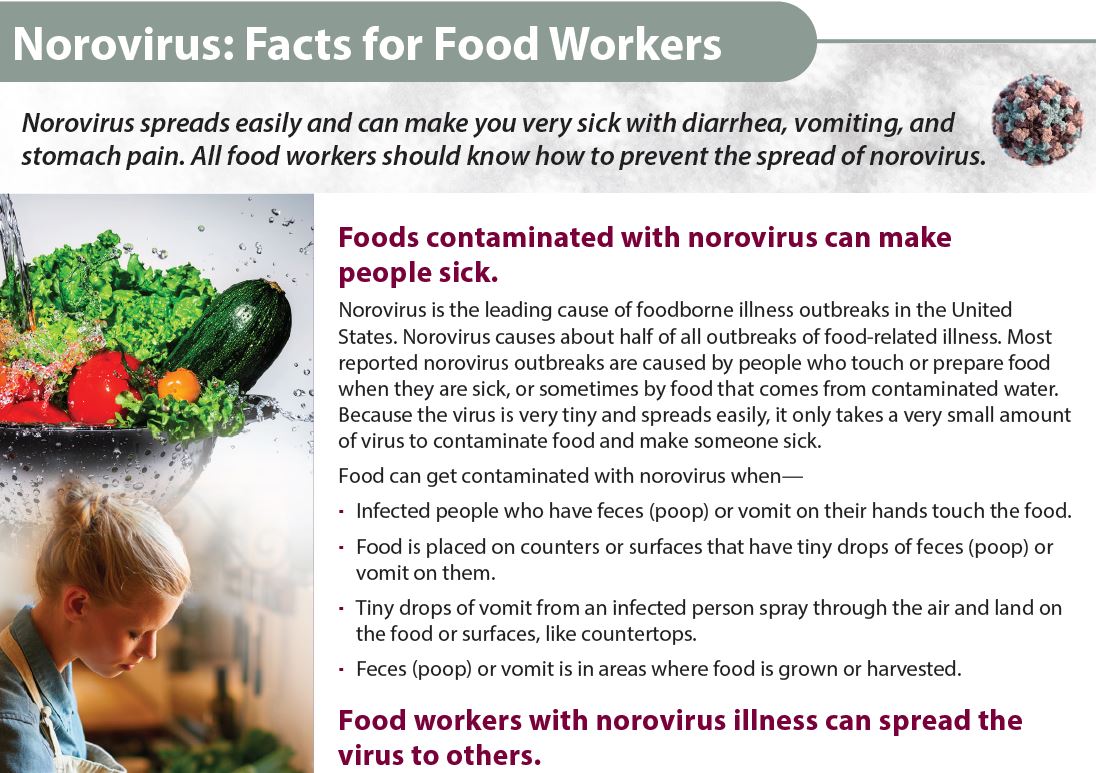Key points
- Each year, there are about 2,500 reported norovirus outbreaks in the United States.
- Most norovirus outbreaks happen when infected people spread the virus to others through direct contact.
- Norovirus outbreaks have been reported in many settings. Some of the most commonly reported outbreak settings are listed below.

When and how outbreaks happen
Most outbreaks of norovirus illness happen when infected people spread the virus to others through direct contact. This can happen by caring for them or sharing food or eating utensils with them. Food, water, and surfaces contaminated with norovirus can also cause outbreaks.
Each year, there are about 2,500 reported norovirus outbreaks in the United States. Norovirus outbreaks occur throughout the year but are most common from November to April.
Current alerts and advisories
CDC works closely with our federal regulatory partners on norovirus outbreak investigations. The following are current food safety advisories or product recalls.
- FDA Advises Restaurants and Retailers Not to Serve or Sell and Consumers Not to Eat Certain Frozen Half-Shell Oysters from Republic of Korea Designated Area II
- FDA Advises Restaurants and Retailers Not to Serve or Sell and Consumers Not to Eat Certain Oysters from Louisiana Harvest Area 3
Previous alerts and advisories
2024
- Certain Oysters from a Portion of Hammersley Inlet Growing Area, Washington State
- Certain Oysters from British Columbia, Canada Growing Areas in BC 14-8
- Certain Oysters from British Columbia, Canada Growing Areas BC 14-8 and BC 14-15
- Certain Oysters and Manila Clams from Pickering Passage, Washington
- Certain IQF Oysters from Republic of Korea
- Certain Frozen, Raw, Half-shell Oysters from Republic of Korea
- Recall of Certain Oysters from Westport
2022–2023
- Certain Oysters from Bahia Salina in Sonora, Mexico
- Certain Oysters from Baja California, Mexico
- Certain Fortune Brand Raw Oysters from Nova Scotia
- Certain Raw Oysters from Dai One Food Co., Ltd., and Central Fisheries Co., Ltd., Republic of Korea
Common settings of norovirus outbreaks
Healthcare facilities
The most commonly reported setting for norovirus outbreaks in the United States and other industrialized countries is healthcare facilities. This includes long-term care facilities and hospitals. Over half of all norovirus outbreaks reported in the United States occur in long-term care facilities.
The virus can be introduced into healthcare facilities by infected patients, staff, visitors, or contaminated foods. Outbreaks in these settings can sometimes last months. Compared with healthy people, norovirus illnesses can be more severe—and occasionally even deadly—in patients in hospitals or long-term care facilities.
Restaurants and at catered events
Norovirus is the leading cause of outbreaks from contaminated food in the United States. About 50% of all outbreaks of food-related illness are caused by norovirus. Most of these outbreaks occur in food service settings like restaurants. Infected food workers are frequently the source of outbreaks in food-service settings, often by touching ready-to-eat foods (such as raw fruits and vegetables) with their bare hands before serving them. However, any food served raw or handled after being cooked can get contaminated with norovirus.
Norovirus outbreaks can also occur from food that is contaminated at the source or on the farm. This can include oysters harvested from contaminated water, or fruit and vegetables sprayed with contaminated water in the field.
Schools and childcare centers
Norovirus outbreaks also frequently occur in schools, childcare centers, colleges, and universities. Norovirus outbreaks on school and university campuses have even led to campus closures. Close quarters, shared spaces, and high-touch surfaces make it easy for norovirus to spread in schools.
Cruise ships
Norovirus is the most frequent (over 90%) cause of outbreaks of diarrheal disease on cruise ships. These outbreaks often get media attention, which is why some people call norovirus the "cruise ship virus." However, norovirus outbreaks on cruise ships account for only a small percentage (1%) of all reported norovirus outbreaks.
Norovirus can be especially challenging to control on cruise ships because of the close living quarters, shared dining areas, and rapid turnover of passengers. When the ship docks, norovirus can be brought on board in contaminated food or water; or by passengers who were infected while ashore. Repeated outbreaks on consecutive cruises may also result from infected crew or environmental contamination. This is because norovirus can persist on surfaces for days or weeks and is resistant to many common disinfectants.



